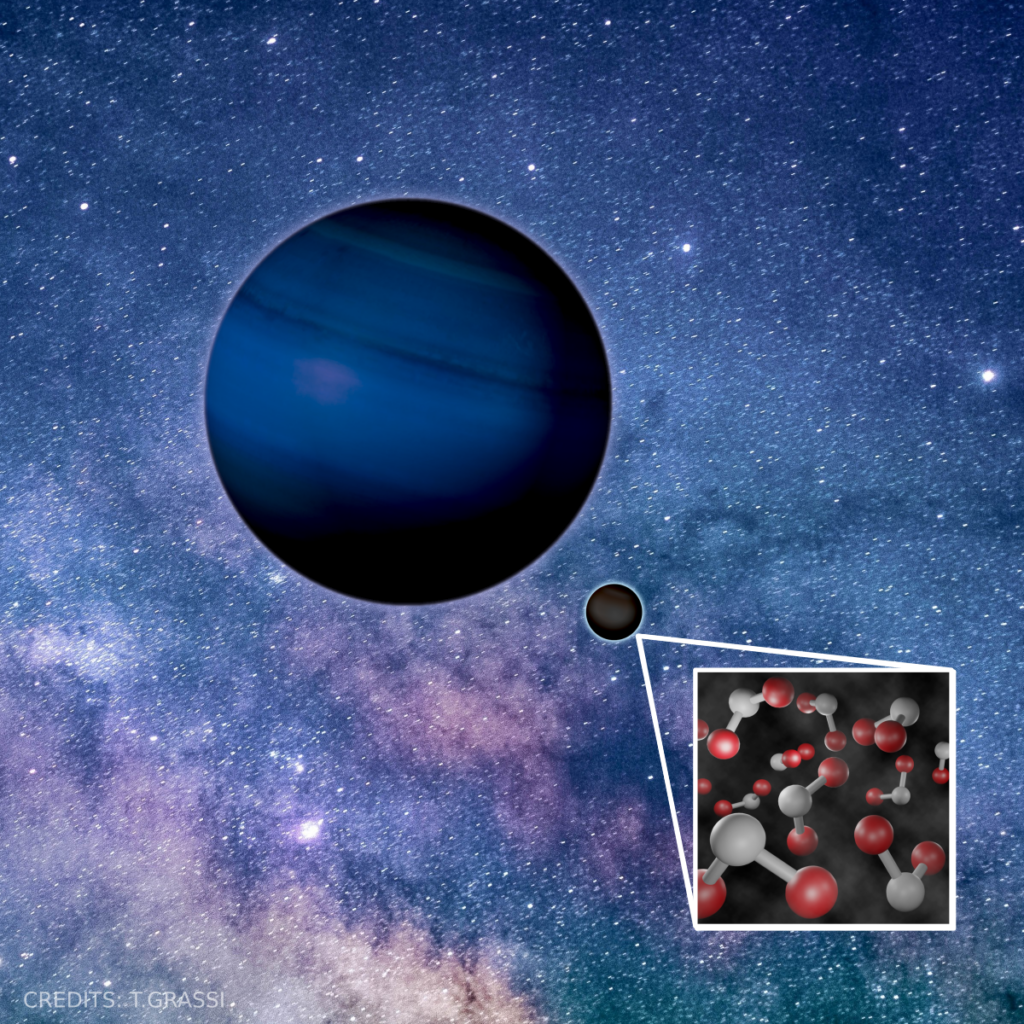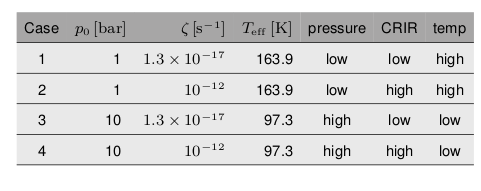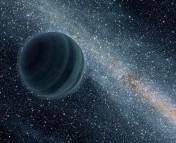Title: Presence of water on exomoons orbiting free-floating planets: a case study
Authors: Patricio Javier Ávila, Tommaso Grassi, Stefano Bovino, Andrea Chiavassa, Barbara Ercolano, Sebastian Oscar Danielache, Eugenio Simoncini
First Author’s Institution: Departamento de Astronomía, Facultad Ciencias Físicas y Matemáticas, Universidad de Concepción, Chile
Status: Published in the International Journal of Astrobiology [closed access]

Credits: Tommaso Grassi
Imagine you are swimming in a lake. It is dark. There is no Sun to be seen in your sky, ever. Instead, most of the sky is swallowed up by the enormous surface of a Jupiter-sized gas giant, which is the center of orbit for this world, its only companion in the great void.
And yet, the water here is not frozen, not even covered by a thick layer of ice. Could this be possible?
Starless Planets
We know that there are many other planets out there, orbiting their own host stars. Some of them may even host moons, much like the Earth, Mars, or most other planets in the Solar System.
But there is another class of planetary bodies. They are called free floating planets (FFP), and they have been theorized about for several decades. These starless planets are thought to have been ejected from their systems due to gravitational forces of other close-by planets or stellar fly-bys. Even the Solar System is said to have thrown out one of its planets long ago, hurling it into darkness and freeing it from the gravitational bond to its host star.
Several FPP candidates have been identified, and statistical estimates show that, on average, there should be 2 Jupiter-mass and 2.5 terrestrial FFPs for every star in our galaxy. It has also been shown that a significant portion of these FFPs are capable of retaining the moons they had before ejection.
The authors of today’s paper have conducted a case study to figure out whether these exomoons of FFPs could in theory be hosts to life. While life existing on planets without a star seems unlikely, there are specific conditions under which an exomoon of a large FFP could retain an atmosphere, which may allow liquid water to exist on its surface.
Heating without a Sun
Usually, in order to determine the habitability of an exomoon, the orbital parameters, the characteristics of the host star, and the masses of the planet-moon system are considered. In this case, however, there is of course no nearby star. The authors therefore deduct that for an FFP exomoon, the orbital parameters hold the biggest influence over the habitability. This is due to the fact that in this scenario, tidal heating is the main way the moon is warmed up to allow for liquid water.
Tidal heating occurs due to the fact that gravitational forces between two bodies are dependent on the distance between them. Any variation in this distance (e.g. if a moon is in an eccentric orbit around its host planet) leads to variations in the gravitational force felt in the interior of the bodies. This leads to movement of material, and thus friction, which heats up the interior of both bodies. Therefore, the more eccentric the orbit of the exomoon is, the stronger the effect of tidal heating.
Modeling an FFP Exomoon
In this paper, the authors modeled the environment of an FFP exomoon. They used a novel approach that incorporates the chemistry of the atmosphere, which is vital in determining the conditions for habitability, by tracking (among other chemicals) the evolution of CO2 and water.
In the simulation, the authors modeled an Earth-mass moon orbiting a Jupiter-mass FFP. The semimajor axis and the eccentricity of the exomoon were left as constant free parameters.
10 Myrs was chosen as the duration of the simulation in order to simulate a time span in which the moon might have habitable conditions. In order to properly simulate the chemical composition of the exomoon’s atmosphere at different heights, the authors needed to properly account for the temperature and density at these points. It is necessary for the moon to have an optically thick atmosphere, which is able to retain the thermal energy and temperature to allow for liquid water on the surface. The authors decided to use CO2 as the main chemical component for their simulated atmospheres (90%) intermixed with some molecular hydrogen (10%). While the H2 is not relevant for the opacity, it is vital for the formation of water within the atmosphere.
Driving Chemistry
Considering the amount of heating produced by the tidal forces, and assuming an optically thick atmosphere, the temperature on the FFP exomoon is still relatively low: approximately 300 K (~ 27°C) or lower. When considering possible chemical reactions in the atmosphere, the authors limited themselves to reactions including molecules formed from carbon, hydrogen and oxygen atoms.
Since there is no incoming stellar radiation, the authors deduce that the main drive behind ionization must be cosmic rays, which directly influence the destruction of, and indirectly influence the creation of, important molecular species in the atmosphere. The cosmic ray ionization rate (CRIR) is chosen for the model between a low value and a rather extreme upper limit (which simulates cases in which the exomoon is located close to a cosmic ray source, such as a gamma-ray-emitting supernova remnant). The authors note that the magnetic field stemming from the FFP host might further decrease the CRIR for the exomoon.
Oceans or Puddles?
Results are given for four different cases with two different surface pressure values and two different cosmic ray fluxes (Table 1).

(Table 1 in today’s paper)
The choice of parameters for all four cases guarantee liquid water on the surface, with a surface temperature above the freezing point of water for that pressure range.
The authors examined the total amount of water present in all four scenarios over the course of 10 Myrs (Figure 2). They find that the total amount of water formed for cases 1 and 2 is similar at 1.32 x 10E17 kg and 1.24x10E17 kg, respectively. However, for case 1, this amount is reached after more than 100 Myrs, while it takes only ~100 years for this to occur in case 2. Cases 3 and 4 reach 2.85 x 10E17 kg and 1.27 x 10E18 kg after ~10 Myrs, respectively. For comparison, the total mass of Earth’s oceans is 1.4 x 10E21 kg. The total mass of the atmosphere is 5.02 x 10E18 kg for cases 1 and 2, and 4.93 x 10E19 kg for cases 3 and 4. For comparison, Earth’s atmosphere has a mass of 5.15 x 10E18 kg.

Right panel: cumulative mass of water after 10 Myrs as a function of pressure.
(Figure 3 of today’s paper)
Figure 2 shows that all of the models have a steady increase in the fractional amount of water over time, which is followed by a stagnation of water increase and mostly ends with a plateau, which is dependent on the CRIR and the temperature throughout the atmosphere of the case.
Models with higher CRIR (cases 2 and 4) reach their maximum mass of water on shorter time scales, due to the fast chemistry by the dissociation of the initial reservoir of CO2 and H2. In case 4, the deeper layers in the higher pressure environment contribute less to this fast chemistry, and therefore the plateau is less prominent. In case 1, the time scale for the equilibrium amount of water is much longer, due to the smaller CRIR. In case 3, the plateau of the maximum amount of water present is not reached by the end of the simulation, due to the high pressure environment further decreasing the effectiveness of the CRIR. Here, the evolution of water content is mostly controlled by the low-temperature chemistry.
A Habitat, nothing like Home
These results point to cosmic rays being the main driver of the necessary chemistry to form water, while tidal forces are the most important source of heating processes on an FFP exomoon. The authors conclude that a significant amount of water can be formed and retained in liquid form on the surface of such a body. The authors note that while their simulation kept the semimajor axis and eccentricity of the system constant, it would be valuable to explore the evolution of the surface conditions while varying the orbital parameters.
This paper shows that under the assumption of stable orbital parameters, and under certain conditions (such as an opaque atmosphere and enough incoming cosmic rays), water will remain liquid after its formation on the moon of an FFP for a long period of time (10 Myrs in this simulation), possibly allowing for the emergence of life.
In humanity’s quest for other lifeforms on different worlds, we have broadened our horizons beyond twins of our own planet. We are gaining a better understanding that life may lurk where we least expect it.
Astrobite edited by Catherine Clark
Image Credit: Today’s paper, Tommaso Grassi




